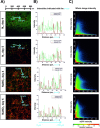Spatial organization and proteome of a dual-species cyanobacterial biofilm alter among N2-fixing and non-fixing conditions
- PMID: 37284766
- PMCID: PMC10308936
- DOI: 10.1128/msystems.00302-23
Spatial organization and proteome of a dual-species cyanobacterial biofilm alter among N2-fixing and non-fixing conditions
Abstract
Many disciplines have become increasingly interested in cyanobacteria, due to their ability to fix CO2 while using water and sunlight as electron and energy sources. Further, several species of cyanobacteria are also capable of fixing molecular nitrogen, making them independent of the addition of nitrate or ammonia. Thereby they hold huge potential as sustainable biocatalysts. Here, we look into a dual-species biofilm consisting of filamentous diazotrophic cyanobacteria Tolypothrix sp. PCC 7712 and heterotrophic bacteria Pseudomonas taiwanensis VLB 120 growing in a capillary biofilm reactor. Such systems have been reported to enable high cell densities continuous process operation. By combining confocal laser scanning and helium-ion microscopy with a proteomics approach, we examined these organisms' interactions under two nitrogen-feeding strategies: N2-fixing and nitrate assimilation. Not only did Pseudomonas facilitate the biofilm formation by forming a carpet layer on the surface area but also did N2-fixing biofilms show greater attachment to the surface. Pseudomonas proteins related to surface and cell attachments were observed in N2-fixing biofilms in particular. Furthermore, co-localized biofilm cells displayed a resilient response to extra shear forces induced by segmented media/air flows. This study highlights the role of Pseudomonas in the initial attachment process, as well as the effects of different nitrogen-feeding strategies and operation regimes on biofilm composition and growth. IMPORTANCE Cyanobacteria are highly interesting microorganisms due to their ability to synthesize sugars from CO2 while using water and sunlight as electron and energy sources. Further, many species are also capable of utilizing molecular nitrogen, making them independent of artificial fertilizers. In this study, such organisms are cultivated in a technical system, which enables them to attach to the reactor surface, and form three-dimensional structures termed biofilms. Biofilms achieve extraordinarily high cell densities. Furthermore, this growth format allows for continuous processing, both being essential features in biotechnological process development. Understanding biofilm growth and the influence technical settings and media composition have on biofilm maturation and stability are crucial for reaction and reactor design. These findings will help to open up these fascinating organisms for applications as sustainable, resource-efficient industrial workhorses.
Keywords: CLSM; Tolypothrix; biofilms; cyanobacteria; microbial interactions; proteomics.
Conflict of interest statement
The authors declare no conflict of interest.
Figures



References
-
- Posten C. 2009. Design principles of photo-bioreactors for cultivation of microalgae. Eng Life Sci 9:165–177. doi:10.1002/elsc.200900003 - DOI
-
- Hoschek A, Heuschkel I, Schmid A, Bühler B, Karande R, Bühler K. 2019. Mixed-species biofilms for high-cell-density application of Synechocystis sp. PCC 6803 in capillary reactors for continuous cyclohexane oxidation to cyclohexanol. Bioresour Technol 282:171–178. doi:10.1016/j.biortech.2019.02.093 - DOI - PubMed
MeSH terms
Substances
LinkOut - more resources
Full Text Sources
